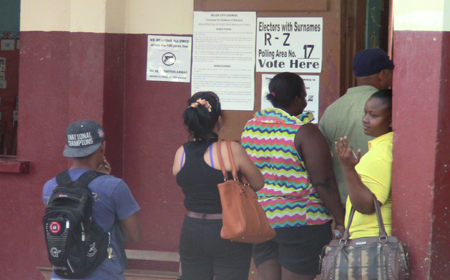BELIZE CITY, Tues. Aug. 16, 2016–Belize has a pool of nearly 200,000 voters spread across 31 constituencies or electoral divisions, and official information from the Elections and Boundaries Department indicates that roughly 73% of them voted in the last general election held on November 4, 2015. The next election is not due until 2020, but by the time that election comes around, many voters could find themselves voting in a different constituency altogether. That is because the Government intends to embark on a national redistricting exercise, as well as re-registration of electors.
Apart from the mandate to ensure that the voters’ list is genuine, the Elections and Boundaries Commission is also tasked with ensuring a fairly even distribution of voters across divisions. The Belize District has 13 electoral divisions, but 10 of them are concentrated in the few square miles covered by Belize City.
Doug Singh, who was formally appointed by the Senate this week as chair of the Elections and Boundaries Commission (EBC), told Amandala that there are two major things that have to be accomplished for the next general election: redistricting and re-registration.
There are concerns that political parties tend to use the process to gain an unfair advantage in electoral politics by tinkering with the political divisions to improve their chances of winning elections.
In response to that question, Singh said, “Gerrymandering is always a possibility—it has never successfully worked in this country.”
Both the Opposition People’s United Party and the third parties have been clamoring for a cleansing of the Belize voters’ list.
“The Commission looked at it to try to make a determination of how the approach would be,” Singh told Amandala.
He said that some of the things discussed are the commitment by the ruling United Democratic Party and the Opposition that there would have been a re-registration, possibly in 2017, but it appears that the Government may first press ahead with redistricting—the realignment of electoral divisions which would effectively change where some electors will vote in the next election.
The last re-registration exercise was done 18 years ago, back in 1998, under the PUP administration of Said Musa. There were 94,173 people on the voters’ list back then; today, the number of electors has more than doubled, totaling 197,905 as of last report in July 2016.
Whereas the Belize Constitution requires that “…each electoral division shall have as nearly as may be an equal number of persons eligible to vote,” the number of electors range from a low of about 3,000 in Fort George, Belize City, to over 9,300 in the Belmopan constituency.
Whereas some argue that a re-registration exercise should be done before redistricting, Singh suggested that a re-registration exercise held so long before elections are due would not be as effective.
“The trend in the past is, what makes people go out and register is the mobilization of the political parties for the next general election, an upcoming election being near. Nobody really rushes out to register on their own,” Singh told us.
He added that because the next election is not due until 2020, it is unlikely that people will rush out to reregister in 2017.
The suggestion is to proceed with redistricting based on what they know about who voted in the last general election held in 2015, and the total number of registered voters per constituency.
Singh said that they have been studying trends over the last three general elections, tracking how things have changed after the 1998 re-registration exercise, by constituency.
Soon after that re-registration exercise, the voter participation rates were up. Today, they have generally declined. Singh said that the Cayo District has seen the largest growth in its electorate.
Redistricting could commence as early as next year, led by a government-appointed task force. As to the process, Singh told us that the decision on how constituencies will be redrawn would ultimately be made by the National Assembly. The recommendations of the yet-to-be-appointed task force would go to the Elections and Boundaries Commission (EBC), a bipartisan body which has two reps from the ruling party, two from the Opposition and one appointed on the recommendation of the Prime Minister after consultation with the Leader of the Opposition.
Landy Espat and Derek Courtenay sit on the EBC for the PUP.
After the last re-districting exercise, the disparity between the largest constituency and the smallest was about 3 to 1, but Government’s then legal counsel, Elson Kaseke, rationalized it by interpreting the Constitutional provision to mean that the distribution of electors should be equal at the district level—a stipulation which does not appear in the Constitution.
Singh said that they do not agree with the interpretation that the numbers should be equalized at the district and not the national level, and even the Opposition has agreed that this is not the spirit of the Constitution.
Although changes under the redistricting and re-registration exercises are pending in the years ahead, the Constitution requires that there shall be no less than 28 electoral divisions. It remains to be seen if new electoral divisions would emerge as a result, or whether some of the smaller constituencies—such as Fort George, which Singh said has shrunk since 2008—would be merged with others.
Singh said that in the case of Fort George, the decrease in the amount of voters is likely due to the expansion of commerce in the area, which he said is normal for urban areas where commerce takes over.
The re-division exercise in 2005 saw an increase in the number of electoral divisions from 29 to 31, with two added for Belmopan and Cayo Northeast.
(Note: Section 90 and 91 of the Belize Constitution address the increase of electoral divisions and the re-division of electoral divisions—both of which could apply in a redistricting exercise.)

